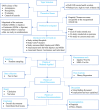Co-occurrence of occupational outcomes and associated factors among hospitals cleaners, eastern ethiopia: a cross sectional study
- PMID: 39529077
- PMCID: PMC11552356
- DOI: 10.1186/s12889-024-20571-0
Co-occurrence of occupational outcomes and associated factors among hospitals cleaners, eastern ethiopia: a cross sectional study
Abstract
Background: Hospital cleaners face a complex and varied work environment due to several potentially dangerous circumstances, including the risk of getting injured by sharp objects and being subjected to various ergonomic and physical risks. They thus acquire a combination or co-occurrence of outcomes associated to their line of work. In this study it stands for occurrence of occupational injuries and musculoskeletal disorders (MSDs) during study period, which has not been explored in developing countries like Ethiopia, particularly among hospital cleaners.
Objective: To assess the prevalence of co-occurrence of occupational outcomes and associated factors among hospital cleaners, Eastern Ethiopia.
Methods: A cross sectional study was conducted on 741 cleaners in eight hospitals in eastern Ethiopia from May, 2023 to 30th August, 2023. Face-to-face interview was conducted. The data quality was maintained by designing standard questions that preserved both external and internal validity. The entered data was exported from Epi-Data 3.1 to Stata 17MP. Descriptive statistic was used to characterize one variable, While, binary logistic regression was used to explore the relationship of the predictors. At binary analysis variables having a p-value of < 0.20 were candidates for multivariate logistic regression. The crude odds ratio and adjusted odds ratio (AOR) with a 95% confidence interval (CI) were presented. Those variables having < 0.05 were reported. The variance inflation factor used to test multicollinearity. While, Hosmer-Lemeshow goodness-of-fit-test was applied for model fit.
Result: From total of 741 hospital cleaners, 679 (91.63%) of them were responded. The prevalence co-occurrence of occupational outcome among cleaners was 25.04% (95%CI: 21.82, 28.47). The multivariate logistic regression shows that those had workload (AOR:2.78, 95%CI: 1.25,6.17), those worked more than 8r/day (AOR:3.45, 95%CI:2.34,6.32), those have sleeping disorders (AOR: 4.61,95%CI: 2.89, 8.03), those had work stress (AOR:2.05, 95%CI:0.98,4.29), those highly exposed with hazards (AOR: 4.22, 95%CI:2.40, 7.45) and those had poor knowledge of risk (AOR:2.41, 95%CI:1.06, 5.50) were more likely increase the odds of co-occurrence of occupational outcome as compared to their counterparts.
Conclusion: The current study concluded that one-fourth of the co-occurrence of occupational outcomes was reported among hospital cleaners. The study also found that lack of supervision, workload, working more hours per a day, severely presence of occupational hazards, lack of regular job rotation, the sleeping disorders and having work stress all increased the odds of co-occurrence occupational outcome.
Keywords: Associated factors; Cleaners; Co-occurrence; Hospital; Injuries; Musculoskeletal disorders.
© 2024. The Author(s).
Conflict of interest statement
Figures
Similar articles
-
Work-related musculoskeletal disorders and associated factors among hospital sanitary workers in public hospitals of Eastern Ethiopia.BMC Musculoskelet Disord. 2025 Jul 4;26(1):640. doi: 10.1186/s12891-025-08873-9. BMC Musculoskelet Disord. 2025. PMID: 40616057 Free PMC article.
-
Sero-prevalence of SARS-CoV-2 antibodies in Ethiopia: Results of the National Population Based Survey, 2021.PLoS One. 2025 May 6;20(5):e0313791. doi: 10.1371/journal.pone.0313791. eCollection 2025. PLoS One. 2025. PMID: 40327714 Free PMC article.
-
Prevalence and associated factors of needle stick and sharps injuries among healthcare workers in northwestern Ethiopia.PLoS One. 2021 Sep 24;16(9):e0252039. doi: 10.1371/journal.pone.0252039. eCollection 2021. PLoS One. 2021. PMID: 34559802 Free PMC article.
-
Home treatment for mental health problems: a systematic review.Health Technol Assess. 2001;5(15):1-139. doi: 10.3310/hta5150. Health Technol Assess. 2001. PMID: 11532236
-
Sertindole for schizophrenia.Cochrane Database Syst Rev. 2005 Jul 20;2005(3):CD001715. doi: 10.1002/14651858.CD001715.pub2. Cochrane Database Syst Rev. 2005. PMID: 16034864 Free PMC article.
References
-
- NIOSH/National Institute for Occupational Safety and Health. Hazards & Exposures.Centers for Disease Control and Prevention. Retrieved 2023-04-08. https://www.cdc.gov/niosh/topics/hazards.html. 2023.
-
- Sleet DA, Carlson Gielen A, Diekman, Shane Ikeda R. Preventing unintentional injury: a review of behavior change theories for primary care. Am J Lifestyle Med. 2010;4(1):25–31.
-
- Trifiletti LB, Gielen AC, Sleet DA, Hopkins K. Behavioral and social sciences theories and models: are they used in unintentional injury prevention research? Health Educ Res. 2005;20(3):298–307. - PubMed
-
- Sleet D, Branscum P, Knowlden AP. Foreword Fam Community Health. 2017;40(1):1–2. - PubMed
MeSH terms
LinkOut - more resources
Full Text Sources
Medical



